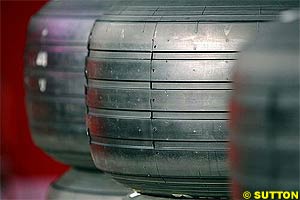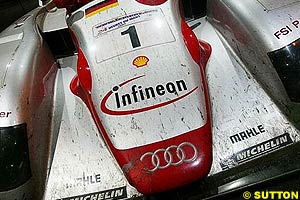
Atlas F1 Columnist
This week's Grapevine brings you |
Last season, the Malaysian Grand Prix represented Bridgestone's worst result, with both Michelin shod Williams finishing ahead of them in the race. This year, they hope to do something about it.
This circuit can see track temperatures get as high as 50 degrees, easily leading to overheating tyres. Producing a construction that degrades gracefully at these temperatures has proven challenging, but Bridgestone believe they have a solution that will challenge Michelin nicely - though they are playing on their analysis of Michelin tyre characteristics to do so.
Over the first hot lap, the Michelin tyres are expected to be very strong, probably holding a slight advantage; however, the French tyres' performance should then drop off for the next six to ten laps, whilst Bridgestone have worked to ensure their tyres continue to perform consistently, with a slow, linear performance drop.
In practice, this is expected to mean that the Bridgestone runners are particularly strong compared to their Michelin competitors for the second through fifth or sixth laps of the race, and for a spell shortly after each pit-stop. Tactically, this is anticipated to provide them with a chance to move rapidly up the grid at the outset of the race, or to make a break from the front. They should then be able to take advantage of strategic pitstops to continue applying pressure.
All that remains now, is to see if the Michelin tyres match the Bridgestone predictions - and whether the Bridgestone runners can take full advantage of it, if they do.
The persistent message from Audi is that Formula One does not represent an economic marketing platform, and its future does not include the sport. Despite this, there are always rumours that the Volkswagen subsidiary is investigating coming in to the sport.
Manufacturers can improve returns in three ways. Increasing margins, reducing overheads or increasing volume. Increasing margins by raising the price is unpopular, as it puts prospective buyers off - or drives them to the competition; reducing the price of components is almost impossible, as years of driving suppliers prices down means there is little room to manoeuvre there. Overheads are principally reduced by reducing the wage bill, either through redundancies leading to a more efficient workforce, or moving the factories to a location that has cheaper workers, or government subsidies. Either way, that involves overheads - build costs for a new factory and the layoff costs for the old, at least, which have to be made up before it shows a benefit: in the current uncertain economy, considering the time-scale for projects like this, it would be considered a risky strategy. That leaves increasing volume, either by taking market share away from the competition, or creating a new market.
Increasing market share is what marketing departments are really about. Launching in to genuinely new markets is rare: people who need a car, generally speaking, buy one. The only 'new' clients at the moment come from bringing prices down enough to entice customers into purchases a new car where otherwise they would have bought second hand. So marketing is all about persuading buyers that your brand is better than the competition's equivalent. In this arena, well spent marketing dollars are key to market share, as buyers are influenced by factors including value for money, performance and image.
Marketing is an art, despite a reliance on science. Statistics based on sales, responses to previous campaigns and surveys are used to identify the 'target customer' and profile them for the factors that decide what and when they buy. However, turning those figures into a better campaign than the competition - who have the same data - is a challenge. In fact, in the absence of an inspirational concept, most campaigns simply serve to reinforce the brand, keep visibility up, and help prevent erosion of that share, and of these, the most effective campaigns are those that show the brand is on a par with its competitors - or better still, is distinguished in almost any fashion.
As sales drop, the cost of losing market share is effectively magnified, which makes it vital to operate a solid marketing program - which is where motorsport, and Formula One in particular, is currently making a difference.
The cost of taking part in Formula One varies between the manufacturers. Ignoring sponsorship income, Honda's engine programme is fairly representative for a fully committed works deal, and apparently sets them back around $80 million a year - which is some 30% more than BMW are spending, but they are involved in developing BAR's chassis program and have contributed materially to the team, too. Renault's expenditure for engine and chassis has been cut back this year, and is expected to come in around $120 million for the year, whilst Toyota are expected to write cheques that hit the $150 million budgeted for this year, as part of their original $750 million five year plan.
Clearly, these are serious figures, even if a significant proportion of these costs can be recouped from sponsorship deals on the car and drivers. But, the sums do add up.
Consider the total time the cars spend on televisions around the world over a Grand Prix weekend in bespoke coverage, then add the exposure in news and sporting programs for the results of qualifying and the race. Include the 'free' advertising from technical sponsors who run their own bespoke advertising campaigns, and the column inches in print in newspapers world-wide. These exposures, when they occur, are connected directly with Formula One - ironically reinforcing the image of performance and excellence by association, even when the actual results are not so good: it was this positive branding that helped to provide a significant boost in Jaguar's sales, despite a dismal first year in the sport.
It is this effect, alongside the expected reduction in costs from the FIA's engine rule changes for 2004 and onwards, and the potential to use the engine in CART in 2005, that has seen VW's Bernd Pischetsrieder talking over the options with both Peter Sauber and Eddie Jordan. Sauber in particular is seen as a good match for VW, as the team is an independent outfit that does tolerably well on customer engines, and appears to have the potential to go further.
Despite these rumours, there is a lot of uncertainly concerning the issues surrounding the end of the Concorde Agreement in 2007. Little surprise that VW are not prepared to entertain a Formula One engine programme until they are certain the investment won't be wasted by the series coming to an unsavoury halt.
![]() Bridgestone Ups the Ante
Bridgestone Ups the Ante
 The Bridgestone-shod F2002 dominated from its introduction after Malaysia last year, beaten only at Monaco by an astute tactical call from McLaren; and Bridgestone believe it has the outright performance to continue winning this year. Accordingly, considering the tyres for the opening races, Bridgestone has looked to right a wrong from last season, and have put together a compound that should stand up far better to the anticipated conditions in Malaysia.
The Bridgestone-shod F2002 dominated from its introduction after Malaysia last year, beaten only at Monaco by an astute tactical call from McLaren; and Bridgestone believe it has the outright performance to continue winning this year. Accordingly, considering the tyres for the opening races, Bridgestone has looked to right a wrong from last season, and have put together a compound that should stand up far better to the anticipated conditions in Malaysia.
![]() VW Examine Formula One
VW Examine Formula One
 A world depression, coupled with the uncertainty of war in the Middle East, has led industry analysts to predict a significant downturn in sales for all the major automobile manufacturers over the coming year. Considering that 2002 was relatively poor in its own right, budgets are being tightened, and demonstrating a solid and improving return per dollar invested is the only way to bean counters at bay.
A world depression, coupled with the uncertainty of war in the Middle East, has led industry analysts to predict a significant downturn in sales for all the major automobile manufacturers over the coming year. Considering that 2002 was relatively poor in its own right, budgets are being tightened, and demonstrating a solid and improving return per dollar invested is the only way to bean counters at bay.
Please Contact Us for permission to republish this or any other material from Atlas F1.
|
Volume 9, Issue 12
Articles
Interview with Geoff Willis
Telling Teammates Apart
Malaysian GP Preview
2003 Malaysian GP Preview
Malaysian GP Facts & Stats
Columns
The Fuel Stop
The F1 Trivia Quiz
Bookworm Critique
On the Road
Elsewhere in Racing
The Weekly Grapevine
> Homepage |